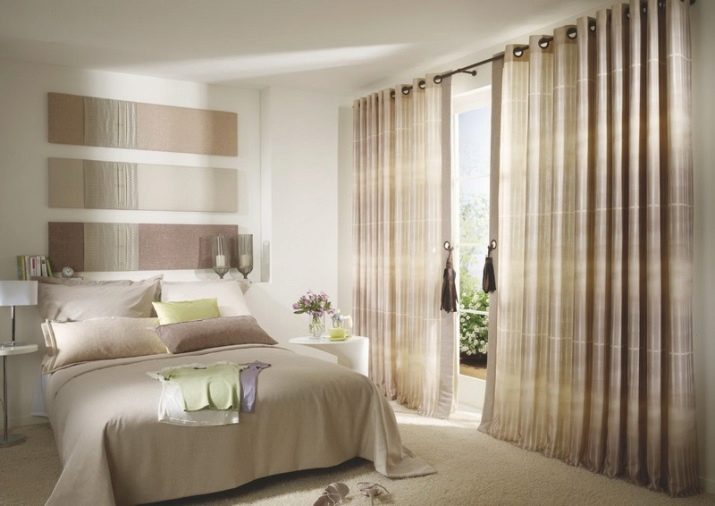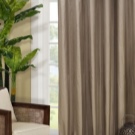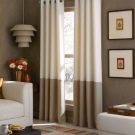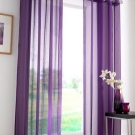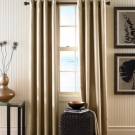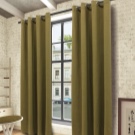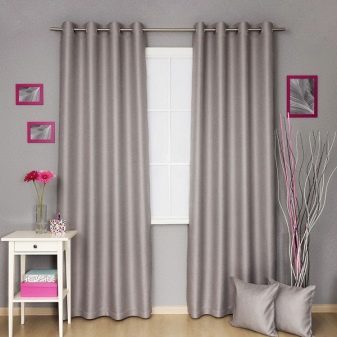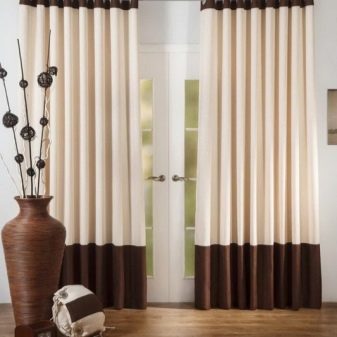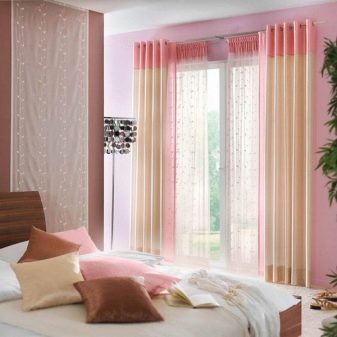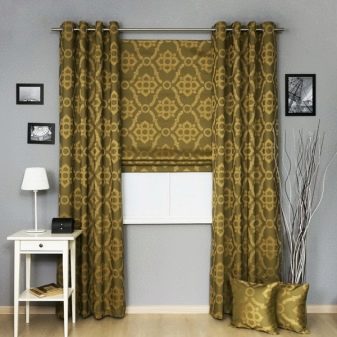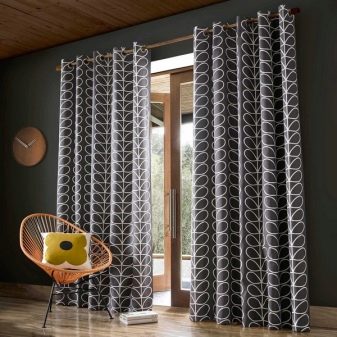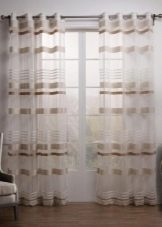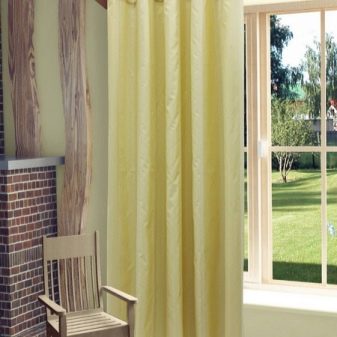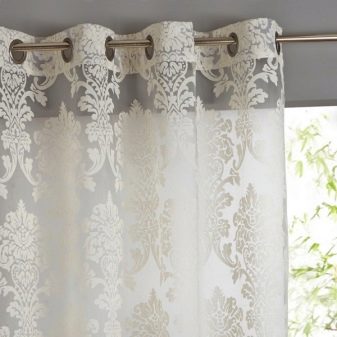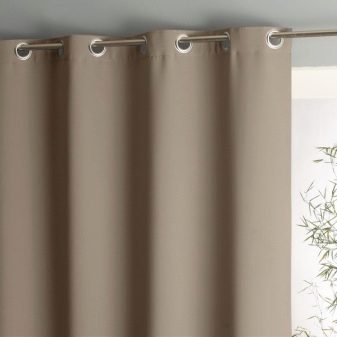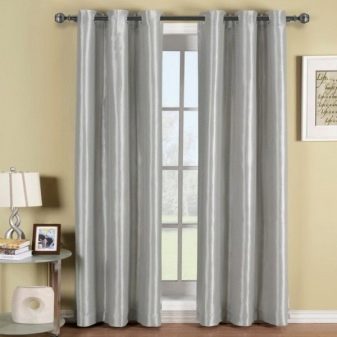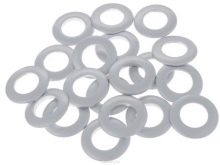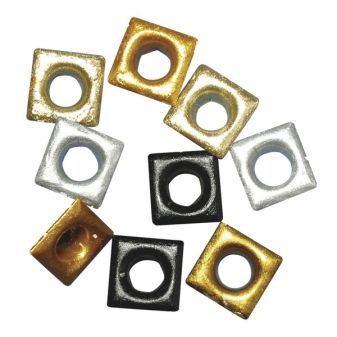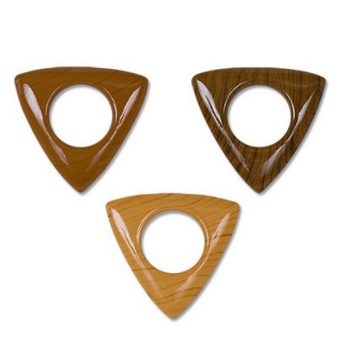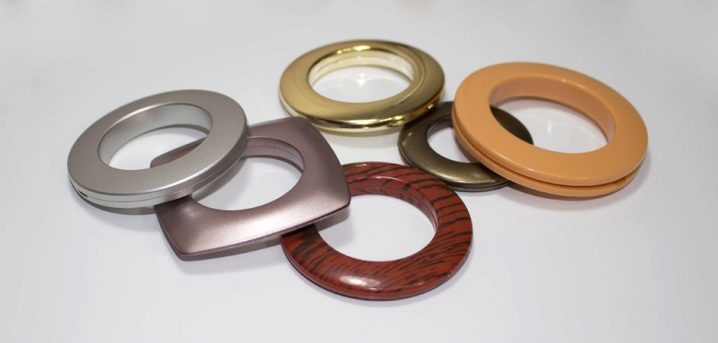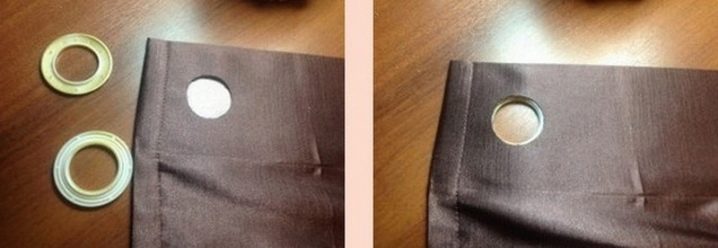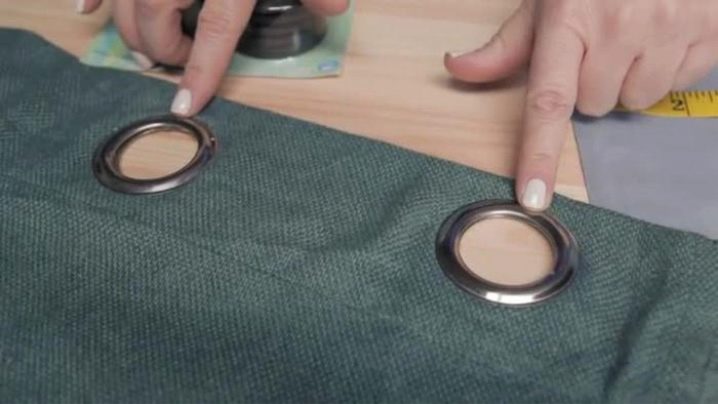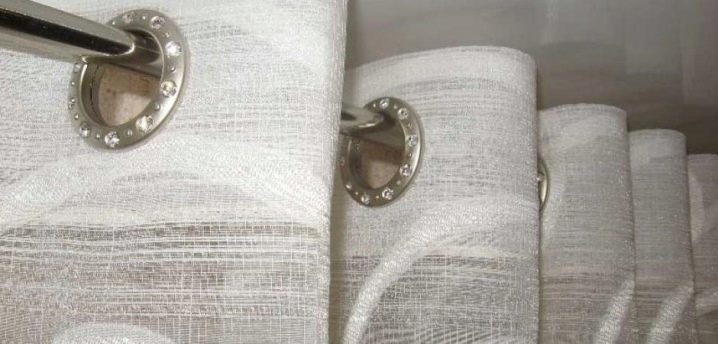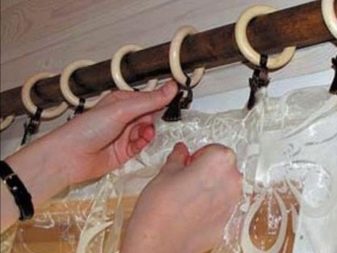How to install eyelets on curtains?
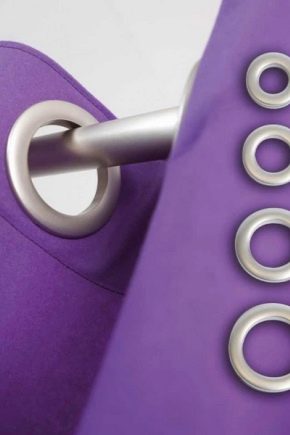
Today, in many homes you can meet neat curtains on the grommet. Such products help to create an unobtrusive, but very attractive design, organically complementing the interiors of different styles. Canvases with eyelets can be purchased ready-made, or you can make them yourself. The article discusses the rules for fixing cringing details on curtains.
What it is?
First you need to answer the question what are such elements as curtain grommets. Most often they are made in the form of rings, which are fixed directly on the material of the curtains. In the future, the grommets are put on the eaves instead of the good old eyelets and hooks.
Advantages and disadvantages
As mentioned earlier, the grommet curtains have gained great popularity and are found in many interiors. The relevance of these copies is due to the fact that they have many important positive qualities. Let's get acquainted with them.
- Fashionable eyelets are good because they open and close seamlessly. This characteristic is due to the fact that, in the process of moving the webs, the edges of the grommets do not cling to the eaves, like simple hooks, so it is very convenient and safe to use them.
- Eyelets provide the most reliable fastening of curtains on the eaves. Cloths can undergo practically any external influences, but at the same time it is extremely difficult to tear them from their main place.
- If necessary, curtains with eyelets can be easily and quickly removed from the eaves. Products on hooks cannot boast with such quality - it can take a long time to remove them.
- Absolutely any models of curtains need to be sent to the laundry from time to time. Grommet options in this matter are considered the most practical. These instances are not only easily removable, but they can also be washed together with the rings - these parts usually hold tightly enough, therefore they do not leave their place during the washing process.
- As a rule, at the end of the washing, the crown paintings are smoothly ironed, since they are simple rectangular pieces of textile - there are no complicated elements or large folds on the material.
- Many needlewomen happy that the eyelets curtains can be made by hand. In this case, you need to properly handle the fabric, and also correctly install the grommets.
- Due to the presence of eyelets, it is possible to form neat folds of the same depth on such curtains.
- Grommet curtains are also good because it is permissible to hang them in almost any room in the house. The main thing is to correctly select the appropriate length (short, medium, long).
- Do not think that all eyelets are of the same type and have a simple rounded shape. In fact, it is possible to supplement the curtain material with more interesting and original details, decorated with aesthetic decor.
Thanks to the listed advantages the grommet are very popular. Many users decide to make such things on their own to save money and bring something truly unique to the interior. However, these products have some drawbacks.
- It should be borne in mind that from the curtains on the grommets it will not be possible to form elegant compositions, complemented by cunning patterns and plexuses. For the formation of multilayer structures will need another bar, which can visually weighting the interior.
- We must not forget that it is permissible to install eyelets in far from all types of fabrics, since some of them give a substantial shrinkage after washing. Subsequently, this may cause serious damage to the material.
Types of fabrics
If it is decided to independently equip the curtains with stylish eyelets, then you should definitely find out which types of textiles are suitable for this.
- Veil. So called fabric, which is not completely transparent, does not shine, but has a delicate structure. It is necessary to take into account the fact that the veil is a capricious material that easily gets dirty, and also accumulates dust on its surface. Cloths from a veil are not recommended to hang up in rooms like kitchen.
- Kisey. This attractive material produces very beautiful rope or thread type curtains.
- Organza. This fabric is characterized by tight weave and a transparent structure. Organza produces very presentable curtains.
- Grid. Often grommets set in this fabric. It consists of many small and large cells. Often the grid is complemented with various patterns in the form of plexuses.
If you plan to hang in the home more dense versions of the eyelet curtains, then you should turn to other popular fabrics.
- Jacquard. This popular and frequently encountered material is characterized by a special aesthetic texture. Jacquard curtains can be made in a variety of palettes. In addition, such products are available with different percentages of density.
- Atlas. From this fabric are obtained insanely attractive and "rich" curtains with eyelets. Atlas is highly hygroscopic. In addition, it is not going to dust.
- Satin. This type of textile is easy and pleasant texture. It produces thick curtains, which are not afraid of regular washing. Such specimens can boast of ecological purity.
- Taffeta. Good grommet curtains come from taffeta. This material is one of the subtypes of natural or artificial silk.It boasts an impressive view - on the surface of the fabric visible spectacular play of light that can transform the interior as a whole.
Crank Types
Curtain eyelets are different. They differ from each other not only in form and design, but also in material.
To begin with, consider the raw materials from which these important parts are produced.
- Plastic. Plastic grommets are inexpensive and are presented in a variety of variations.
- Metal. Metal options are rightly recognized as the most durable and strong.
- Tree. Such grommets look great, but over time they can begin to crack and crack, especially if they are made from natural raw materials.
Creeping elements differ in shape. So, it is possible to meet the accessories differing in the following structure:
- square;
- rounded;
- triangular;
- polygonal
- in the form of flowers, animals, insects and other objects of a similar type.
The optimal structure of the grommets must be chosen in accordance with the style of the interior. For example, in more stringent or classical ensembles, concise square or round products will be the best solution.As for the more original and daring settings, the grommets in the form of flowers or animals are permissible here.
Cringles can be supplemented with various kinds of decorative components. Thanks to such decorations, these details can take on a more visible and eye-catching look. In our time on the shelves will meet the grommets, supplemented by:
- a matte or more noticeable glossy finish;
- elegant gilding or silver plating;
- a coating that mimics the skin of natural origin;
- multi-colored beads;
- shining rhinestones.
How to install by yourself?
If it is decided at home to install the grommets in the curtain fabric, then First you need:
- do some calculations;
- buy curtain material (if necessary, you should buy a fabric for the lining);
- purchase the grommets themselves, the grommet, or dublerin (the band width parameter must be greater than the outer diameter of the mounting not less than 2 cm)
You need to properly prepare the work surface. It is permissible to install the grommets both on the floor and on the ironing board.
It is very important to calculate the number of grommets.
To do this, measure the diameters inside and outside the mountings, and also take into account certain nuances.
- In order for the curtain to look neat and its edges face the wall, the number of fasteners must be even.
- It is recommended to leave a distance of approximately 18 cm between the central sections of the crown elements (it is possible from 15 to 20). If there is a double cornice, then it will be necessary to take into account the gap between the rods, so that the paintings do not touch each other.
- The pitch from the side to the center of the first attachment should be from 5 to 7 cm - it all depends on the width of the fold, as well as the outer diameter of the grommet. It is necessary to ensure that the fasteners do not intersect with the seam, otherwise they simply will not close.
Next, you need to competently prepare the curtain itself for the installation of eyelets.
For this you need:
- moisten textiles, then dry a little and walk with an iron (carrying out these procedures will avoid shrinkage of curtains after washing);
- sew the lining;
- in the end of the preparation of the fabric to process the seams.
Making seams is as follows:
- first, the future curtain should be laid out on a previously prepared, even basis;
- then it should be noted and ironed on the side of the wrong side 2 cm;
- make a second turn with the width of the grommet;
- then it is necessary to lay a ribbon between the woven layers, making indents on the sides with the width of the deflections;
- now the ribbon is glued with the help of an iron (it is desirable to do this in modest areas);
- then it is permissible to stitch material along the marginal half of the cuff, indenting 2 mm.
As for the treatment of seams from the bottom and sides, everything depends on the specific type of textiles, as well as personal preferences of the master.
Now you can go to the very installation of eyelets. To do this, iron the curtain and spread it on a flat surface.
First, the extreme elements are fixed:
- you need to make marks with chalk or a pencil in accordance with the calculations made in advance - these will be the central points of future fixtures;
- now you need to put the grommet and draw its inner diameter;
- then you should take a good sharp scissors or a special piercer and make holes with them, which in the end will turn out to be slightly larger than the intended circle;
- it is necessary to cut the necessary sections with maximum accuracy,so that the edges of the material do not fall off;
- put the first part of the grommet under the material, and the second part from above;
- Click on the mount until it clicks.
The same should be done with fixing fasteners on the other side. After that, relying on the calculated distances, mark the central points of the remaining rings and outline their internal diameters. Here you need to ensure that all the crown elements are located at equal height from the edge of the curtains. Then the necessary holes are cut out again and the remaining grommets are fixed. This work will be completed, and the finished canvas can be hung on the eaves in the selected room.
Tips and tricks
The specialist advises to place the cringing curtains before washing in special bags so that the fasteners (especially if they are made of metal) do not damage the washing machine drum. When choosing the washing mode, it is better to set up sparing programs. If in the process of washing textiles knocked out from under the ringlets, then they will have to be rearranged after the material is completely dry.
Eyelets, like curtain fabric, should be selected in accordance with the style of the interior.For example, in classic ensembles, the wooden elements of simple geometric shapes look best, and in more progressive modern environments, you can turn to metal / chrome-plated specimens.
Holes for installation of eyelets should be done as carefully as possible, so as not to accidentally damage the fabric. Experts say that you can install only plastic grommets with your own hands. If you want to use parts made of metal, then you will need specialized equipment to fix them. Today, there is a good alternative to canvases with rings - products with the effect of an eyelet. Similar models may have other fasteners, but images and prints imitating eyelets are applied in their upper part.
How to install eyelets on the curtains, see the following video.

